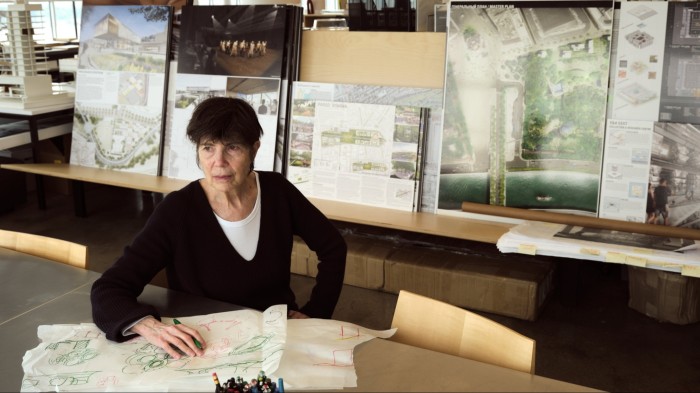Elizabeth Diller’s office is in a corner of a huge, open-plan loft in a former warehouse building in Chelsea. I meet her on a Friday afternoon, when the office is Friday-quiet and the sun is sparkling on the Hudson. The building, which occupies an entire city block, once had freight trains running into it.
It’s a nice reminder that Diller Scofidio + Renfro, the studio she co-founded with her husband Ricardo Scofidio in 1981 (Charles Renfro became partner in 2004), is best known for the High Line. The transformation of a disused freight rail line into what has become an astonishingly successful elevated linear park radically remade the landscape of Manhattan’s west side a couple of blocks away.
I’m apologetic about conducting the interview now. Only a few weeks before, Scofidio died. Diller’s colleagues had assured me that she was happy to be distracted by talking about her work.
It is tinged with sadness, but this year brings the practice back into the global spotlight. On May 31 the V&A East Storehouse will open on the edge of London’s Queen Elizabeth Olympic Park. Sited in part of the huge former Olympics Media Centre it is an ingenious reuse of an existing structure and represents a remarkable opening up of the museum’s massive collection. At the Venice Biennale meanwhile there is a bookshop and an installation that makes coffee out of canal water.
All these projects appear closer in intellectual ambition — rethinking institutions, technology and public space — to Diller and Scofidio’s early work than they do to the big architecture their studio has become known for. A classic example of the latter is the Shed, situated a few blocks away from their office — a transformable blockbuster which acts as the cultural component for the Hudson Yards development. Nearby is Pier 57, turned into a massive tech-campus on the water for Google. Just beyond that is their 88-storey 15 Hudson Yards, one of the city’s best recent skyscrapers.
The list continues across the globe, from Los Angeles, where they are working on a new phase of the Broad art museum, to Adelaide, where the Tarrkarri Centre for First Nations Cultures is emerging from Kaurna land. There is also the Al-Mujadilah Center and Mosque for Women in Qatar, the first contemporary purpose-built mosque for women in the world. It is a remarkable building with a perforated concrete carpet of a roof floating over it; bright, light, fluid and open.
Yet when Diller and Scofidio broke onto the scene they were known for challenging the orthodoxies of the big builders, the late modernists and the postmodernists. They were doing something more nimble, working in galleries and on paper, in academia and in text. “There was a kind of resistance,” Diller tells me, “that came with the 1970s.” (She still sports the same radical chic almost-quiff and black-framed glasses she did half a century ago.)
“I lived down in the East Village and New York was quite depressed then, post-industrial but pre-anything. It was the time when artists could find huge lofts. The space allowed you to do experimental work, down and dirty and very liberating.”

If she seems the archetypal New Yorker, Diller was actually born in Poland in 1958 and moved with her family to the US in 1960. She studied at the Cooper Union School of Architecture where she met Scofidio — who was one of her tutors. Their first work together, says Diller, was Traffic in 1981. It was a 24-hour installation of thousands of orange traffic cones in the traffic island of Columbus Circle, a striking piece of visual protest about the sheer waste of public space incurred by traffic engineering.
Their first major architectural moment came two decades later and was hardly a building at all. Blur Building, built for the Swiss National Exposition in 2002, was a skeletal structure set on Lake Neuchâtel which was enveloped in a cloud of vapour so that the pavilion vanished.
“Expos were all about showing off technology,” Diller says, “so we made a decidedly lo-fi project, a critique. It was controlled by an early AI system, learning from its own information. We made a space where there was nothing to see.”
It was inspired, Diller tells me, by the writings of French philosopher Hubert Damisch. But it was also fun, something children could enjoy as much as adults. And it was pure experience. The architects resisted the temptation to resurrect it somewhere else — it now exists as a memory.
Their 1989 show at MoMA still haunts the architectural imagination. Para-Site was a sinister installation of cameras and strange mechanisms which surveilled the audience. “It was critical,” she says, “about the way people look at the museum and the way the museum looks at them.” Three decades later they would redesign MoMA itself.


Another piece, Soft Sell (1993), consisted of footage of a vivid red-lipsticked mouth projected on to an abandoned porn theatre in Manhattan. “We were happy,” Diller tells me. “We were the first architects ever to receive a MacArthur grant [in 1999] and that validated that what we were doing was architecture. It was critical, social, political. We were teaching too and the idea of doing professional architecture never really entered my mind.
“We came out of the institutional critique but then we realised that it was people like us who were now running the institutions. We went from cutting up walls to building them. The thing is, now we realise that we really want those institutions. That is what civil society is.”
Diller shows me the practice’s new book, its first monograph. It has a curious format: two books bound together. One part is titled simply “Architecture”, the other “Not Architecture” — split between the buildings and the writings, art and conceptual projects. It’s a labour of love, and the perfect encapsulation of the move from institutional critique to institution building.
Now her practice is building like mad. It has no established single style, looking at each project as a new experience. “If societies and cities change,” Diller asks me, rhetorically, “how does architecture keep up? It’s slow, heavy and expensive. How do you produce architecture that doesn’t default to the generic?”

She points to the Lincoln Center, on which her practice has been working for decades, slowly upgrading the public and performance spaces, as a defining project. But also, more surprisingly, to 9/11. “New York had gone through this trauma but there was something new in the air, a sense of citizenship. With the High Line we felt like architecture could do something for the city.” But the High Line also became a conduit for hyper-gentrification, an accelerator for development on either side, which has ended up looking like a kind of architectural menagerie. Diller rolls her eyes a little, well aware.
In Venice the practice will be involved on three separate sites. With the V&A it will explore the architecture of storage, in an installation that will focus on the storage life of a toothbrush as a way of exploring global supply chains, containerisation, warehousing and retail practice.
The firm will also be designing a new temporary bookshop of the Biennale, a delicate, temporary tensile structure and another intervention, an intriguing-sounding installation which will filter and transform Venice canal water into espresso. “I’ll be drinking the first cup,” she shoots before I can ask any more questions.

dsrny.com
Find out about our latest stories first — follow FT Weekend on Instagram and X, and sign up to receive the FT Weekend newsletter every Saturday morning









